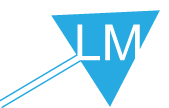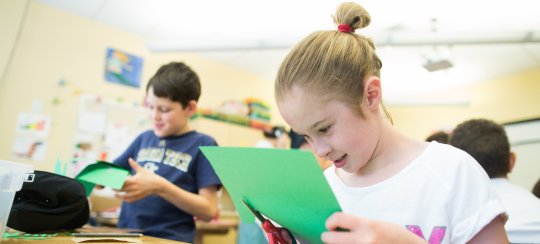By the end of this lesson students will be able to make choreography choices that reflect the words and phrases in a poem.
“I can describe how different words and phrases communicate different feelings and images in a poem.”
LESSON OVERVIEW
| Steps |
Pacing: 60 Minutes |
|
|
10 Minutes |
|
|
50 Minutes |
Standards Alignment
Speaking & Listening
SL 3.1a: Come to discussions prepared, having read or studied required material; explicitly draw on that preparation and other information known about the topic to explore ideas under discussion.
SL 3.1b: Follow agreed-upon rules for discussions (e.g., gaining the floor in respectful ways, listening to others with care, speaking one at a time about the topics and texts under discussion).
SL 3.1c: Ask questions to check understanding of information presented, stay on topic, and link their comments to the remarks of others.
SL 3.1d: Explain their own ideas and understanding in light of the discussion.
SL 3.6: Speak in complete sentences when appropriate to task and situation in order to provide requested detail or clarification.
SL 4.1a: Come to discussions prepared, having read or studied required material; explicitly draw on that preparation and other information known about the topic to explore ideas under discussion.
SL 4.1b: Follow agreed-upon rules for discussions and carry out assigned roles.
SL 4.1c: Pose and respond to specific questions to clarify or follow up on information, and make comments that contribute to the discussion and link to the remarks of others.
SL 4.1d: Review the key ideas expressed and explain their own ideas and understanding in light of the discussion.
SL 4.6: Differentiate between contexts that call for formal English (e.g., presenting ideas) and situations where informal discourse is appropriate (e.g., small-group discussion); use formal English when appropriate to task and situation.
SL 5.1a: Come to discussions prepared, having read or studied required material; explicitly draw on that preparation and other information known about the topic to explore ideas under discussion.
SL 5.1b: Follow agreed-upon rules for discussions and carry out assigned roles.
SL 5.1c: Pose and respond to specific questions by making comments that contribute to the discussion and elaborate on the remarks of others.
SL 5.1d: Review the key ideas expressed and draw conclusions in light of information and knowledge gained from the discussions.
SL 5.6: Adapt speech to a variety of contexts and tasks, using formal English when appropriate to task and situation.
Teaching Resources
-Unit 5, Tracks: “BrainDance of Words" #
1,
2,
3, and
4 by Debbie Gilbert
-Laptop or Tablet
-Speakers (Optional)
Unit 5 includes the following Life & Learning Skills:
-Reflective thinking
-Creative problem-solving
-Critical and analytic thinking
-Collaboration Communication
 Differentiation Options
Differentiation Options
Differentiation Options will appear throughout the unit to suggest ways to scaffold or challenge student learning. Use the number of helping hands to select the level of differentiation that best supports student learning.


 Highest level of scaffolding. Select this option if students are learning strategies for the first time, if the text is challenging for them, or if students require more guidance during activities. Part 1 lessons are written for the highest level of scaffolding.
Highest level of scaffolding. Select this option if students are learning strategies for the first time, if the text is challenging for them, or if students require more guidance during activities. Part 1 lessons are written for the highest level of scaffolding.

 Moderate scaffolding. Select this option if students require some support comprehending the text or navigating the activity.
Moderate scaffolding. Select this option if students require some support comprehending the text or navigating the activity.

Least amount of scaffolding/Extending the instruction. Select this option if students are ready to work more independently, move more quickly through the material, or are ready for additional challenge.
 Leveraging Moments
Leveraging Moments
Key instructional steps where the arts are used to leverage literacy-learning (and vice versa) are marked with  . Smaller leveraging moments also occur throughout the lessons.
. Smaller leveraging moments also occur throughout the lessons.
Process: Give an overview of the lesson objectives, which are to select music and continue to choreograph dances.
Suggested Dialogue
"By the end of today’s lesson, you will be able to say, 'I can describe how different words and phrases communicate different feelings and images in a poem'.”
Process: Transition to dance and move desks.
Suggested Dialogue
Getting Ready for BrainDance
"When I say 'Go,' move the desks and find an empty space in the room for our BrainDance warm-up. Go!"
Process: Lead the students in one of the four BrainDances of Words. Below are the cues for BrainDance #4, but feel free to select one of the other BrainDances. Students stand at the sides of their desks. Use the audio track with verbal cues and musical accompaniment for the BrainDance. If desired, instead of using the audio track, use the verbal cues below to guide students through the BrainDance. This can be facilitated as a generic BrainDance without descriptive words, with descriptive words, with or without music.
Suggested Dialogue
Warming Up with BrainDance
"We’ll start by warming-up our bodies and brains with the BrainDance to prepare us to choreograph our Words in Motion! dances.
Breath: Breathe quietly.
Tactile: Bouncily tap your head, your arms, your fronts, your backs, your legs, and your feet.
Core-distal: Expand your body into an enormous shape and contract into a miniscule shape.
Head-tail: Ripple your body forwards and backwards and from side to side.
Upper half: Freeze the lower half of your body. With the top half of your body, move suddenly.
Lower half: Freeze the top half of your body. With the lower half of your body, move gently.
Body-half right: Freeze the left side of your body. With the right side, move playfully.
Body-half left: Freeze the right side of your body. With the left side, move nervously.
Eye-tracking: Follow your right thumb with your eyes. Move it angrily from side to side. Follow your left thumb with your eyes. Move it unhurriedly from side to side.
Cross-lateral: Purposefully reach your arms across the front of your body on different levels.
Vestibular: Aggressively spin and then freeze in a hopeful shape.
Breath: Breathe quietly."
Process: Students select music for their dances and continue to choreograph the rest of their poems. Have students open to page 26 in their A4L Notebooks if they are using the Choreography Preparation Chart to support their process. The recommended music selections include three songs on the Unit 5 with music by Eric Chappelle: “Up and At ’Em”, “Totem Pole”, and “Little Bolero”. “Up and At ’Em” has a strong, steady beat. “Totem Pole” is soft and mysterious and has interesting percussion sounds. “Little Bolero” is slow and powerful. Feel free to eliminate the option of music for the Words in Motion! dances.
Play all three music options for the whole class. Groups discuss which music selection they think is a good match for their poem. Give each group 5–10 minutes to listen again, try out, and/or select a song. If available, each group could use a personal listening device to play songs and make decisions.
Teaching Tip: Options for Selecting Music
All groups use the same music. Use 3 MP3 players, or internet-connected devices with each group that picks the same music working in the same area.
Alternate playing each piece of music so each group takes turns practicing with their music.
All groups work without music.
Guidelines for Choreography & Prosody
Ask yourself the following questions as you create your dance with shape, movement, and vocal choices.
- What movement and shape choices will help you show the feelings and images in the poem?
- Will you say the lines of the poem before or during the dance?
- How will you say the lines to communicate the images and feelings and to support your movement choices?
- Will you repeat any movements?
Suggested Dialogue
Introducing the Music Selections
"Get with your group and have a seat. Today we will select music for our dances and work toward finishing our choreography. I will play three selections of music. These are your options for the music that will play during your dance. You can also choose not to use music and only have your voice as accompaniment to the dance."
"The first selection, “Up and At ’Em,” has a strong, steady beat. The second selection, “Totem Pole,” is soft and mysterious and has interesting percussion sounds. The third selection, “Little Bolero,” is slow and powerful. Let’s listen to each selection." (Play music.)
"Discuss with your group which selection you think will be best with your poem." (Students discuss.)
Guiding Groups to Continue Choreography and Select Music
"I will come around to each group so you can listen again to select your music and even try the selections with what you’ve choreographed. Then you’ll make your final selection. While I’m roaming the room, work with your group to review your beginning shape and first movement. Then make movement choices for the other sections of your poem and an ending shape for the final section of your poem."
"Use the Guidelines for Choreography & Prosody chart to support your dance and vocal choices."
Process: Restore the room to its original state. Tell students how and where to move the desks and where you want them to go once they’ve moved everything.
Process: Close the lesson with a look forward describing the next lesson.
Suggested Dialogue
"In our next lesson, we’ll finish our dances with prosody, practice them with music, and share our work with each other."
Performing The Closing Ritual (Optional)
"To close our theater lessons, we'll appreciate our work and each other with a unified clap.
On three we'll all clap once and say, 'Huh!' 1-2-3 (clap) Huh!"
CONGRATULATIONS ON COMPLETING LESSON 13! YOU ARE NOW READY TO MOVE ONTO LESSON 14 OF UNIT 5.

 Differentiation Options
Differentiation Options ![]() Leveraging Moments
Leveraging Moments
